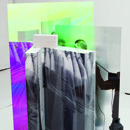Wesleyan University's Ezra and Cecile Zilkha Gallery presents "Picture/Thing" January 27 through March 1, 2015

presents
Picture/Thing
Tuesday, January 27 through Sunday, March 1, 2015
Main Gallery, Ezra and Cecile Zilkha Gallery
Middletown, Conn.–Picture/Thing, an exhibition curated by Assistant Professor of Art (Photography) Sasha Rudensky and Professor of Art (Sculpture) Jeffrey Schiff, presents works by ten artists who make hybrid objects that challenge the limits of photography and sculpture. The exhibition features works by Kendall Baker, Isidro Blasco, Rachel Harrison, Leslie Hewitt, Jon Kessler, Anouk Kruithof, Marlo Pascual, Mariah Robertson, Erin Shirreff, and Letha Wilson. The exhibition will be on view in the Main Gallery of Wesleyan University’s Ezra and Cecile Zilkha Gallery, located at 283 Washington Terrace on the Wesleyan campus in Middletown, Connecticut from Tuesday, January 27 through Sunday, March 1, 2015. Gallery hours are Tuesday through Sunday from Noon to 5pm. Gallery admission is free.
An opening reception will be held on Tuesday, January 27, 2015 from 5pm to 6:30pm in the Main Gallery of the Ezra and Cecile Zilkha Gallery, with a talk by the curators Sasha Rudensky and Jeffrey Schiff at 5:30pm. The snow date for the opening reception is Thursday, January 29, 2015 from 5pm to 6:30pm. Admission to the opening reception is free.
A lecture by artist Rachel Harrison will be held on Wednesday, February 11, 2015 at 4:30pm in the CFA Hall, located at 287 Washington Terrace on the Wesleyan campus in Middletown. Admission to the lecture is free.
An artist panel with Leslie Hewitt, Jon Kessler, and Letha Wilson; and the curators Sasha Rudensky and Jeffrey Schiff; will be held on Tuesday, February 24, 2015 at 4:30pm in the Main Gallery of the Ezra and Cecile Zilkha Gallery. Admission to the artist panel is free.
"The proliferation of digital photographs, created and shared without ever taking a material form, makes us question our relationship with physicality," says Jeffrey Schiff. "Contemporary artists recognize this development, but also contest it by grounding photographs in material objects."
"In this exhibition, the content of the photographic image as a representational object gives way to the experience of perception itself," says Sasha Rudensky. "By shifting between two and three dimensionality, we are asked to be conscious of our viewership and to question the historic conventions of photography and sculpture."
The artists featured in the exhibition take varying approaches to material, technology, and presentation, expanding and redrawing the traditional perimeters of both. Defying photography’s specificity as a “window onto the world,” some prioritize the materiality of the photograph over the actual image, while others migrate the graphic flatness of the photograph into the full dimensionality of the sculptural realm. Undoubtedly a response to the immateriality and infinite reproducibility of digital technology, the surveyed works insist on both the physical presence and uniqueness associated with sculpture, and the indexical relationship to the physical world exemplified by photography, resulting in a new formulation: a picture/thing.
In a material sense, a photograph is an abstraction—a combination of silver particles, marks imbedded in paper, on metal, or canvas that remain meaningless to the viewer until they add up to something nameable, familiar, a picture of a thing. For most of its nearly 200 year history, photography has excelled at recording the things of the world, depicting the three dimensions of objects and spaces as graphic inscriptions on a plane. Photography’s capacity to represent full dimensionality in a flat, bounded picture has enabled images of things to be replicated and shared, untethered to a specific locale or moment in time.
Sculpture, on the other hand, in its long history, has been predicated on a resistance to flatness. Because of its insistent materiality, its indissoluble “thingness,” and especially because it could never be fully comprehended from a single vantage point, sculpture refuses transformation into a graphic picture, and insists on the viewer’s presence and movement in its particular time and place. Sculpture enacts its own materiality, its “thingness” in space, its direct pronouncement of the means of its making.
